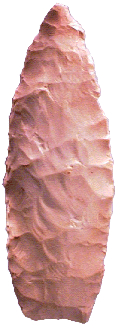

Point Type: AGATE BASIN
Also See: Allen, Angostura, Eden, Guilford, Lerma, Nebo Hill, Sedalia
Location: Midwestern and Eastern United States
Associated Dates: 9,500 - 8,500 B.P. - Transitional Paleo - Early Archaic
Morphology: Lanceolate
General Description: The Agate Basin is a medium to large sized long, slender lanceolate unfluted blade which is usually skillfully made, especially specimens from the west. The basal edge is either concave, convex or straight and is typically ground. The blade edges are most often excurvate to slightly parallel with basal grinding extending from one-fourth to one-third of the length of the blade from the base. Basal thinning is usually not present. The cross section is typically lenticular.
In the central and eastern states areas, flaking on Agate Basin specimens is usually random with only a few points showing fine horizontal flaking. The differences in this flaking shows the influence that reached the eastern states from the west during the terminal Paleo Early Archaic transitional phase. A type of Agate Basin is found in many areas of the eastern United States however these points are cruder and lack the horizontal flaking most often seen in points originating from the western states. The eastern specimens are not as delicately made and the flakes are wider and larger.
There seems to be very little information in regards to the central primary distribution area of the Agate Basin type. However, studies of collections indicate that the point can be found in the following states: Wyoming, Colorado, New Mexico, Texas, Oklahoma, Kansas, Nebraska, Iowa, Missouri, Arkansas, Minnesota, Illinois, Michigan, Indiana, Ohio and much of south-central and southwestern Canada.
The size of Agate Basin point can range from 63 mm to 128 mm in length. The typical width is less than 32 mm. Thickness averages 8 mm. The Agate Basin was named by Frank H. H. Roberts Jr. in 1943 for examples that were recovered from the Agate Basin site in eastern Wyoming. The point type was further described by H. Marie Wormington in 1957.
About the Point Above: The small Agate Basin point at the top of this page, was found in Lincoln County, Missouri on May 16, 1925 and is from the former Frank Morast collection. The point is made from a white Burlington Chert and is heavily patinated, especially along the blade edges. There is a very small chip out of the upper or left hand blade edge near the tip. There is some parallel flaking on this blade. The edges are ground 22 mm up each blade edge from the base. The cross section is lenticular. Overall, the point measures 71 mm in length, is 28 mm wide and is 8 mm thick in mid blade 22 mm from the base. The concavity of the base is 1 mm deep and the base is 4 mm thick and 15 mm wide. Catalog Number 5-80-H
References: Dragoo (1, 4), Edler, Justice, Overstreet, Perino (1, 3), Waldorf
© Copyright 1997 - 2008 LITHICS-Net WWW.LITHICSNET.COM
Use Your Browser's BACK Button to Return to the LITHICS-Net Index.